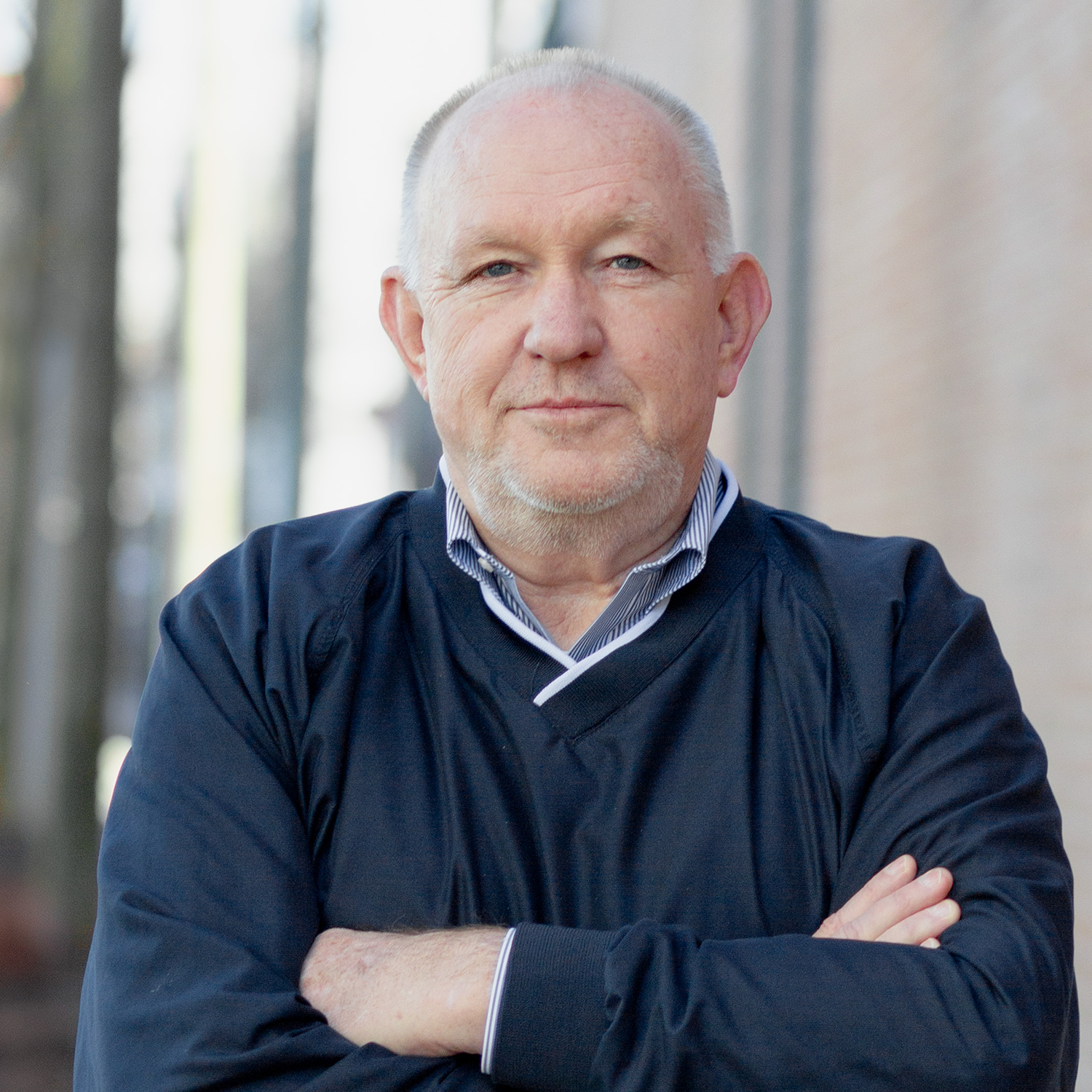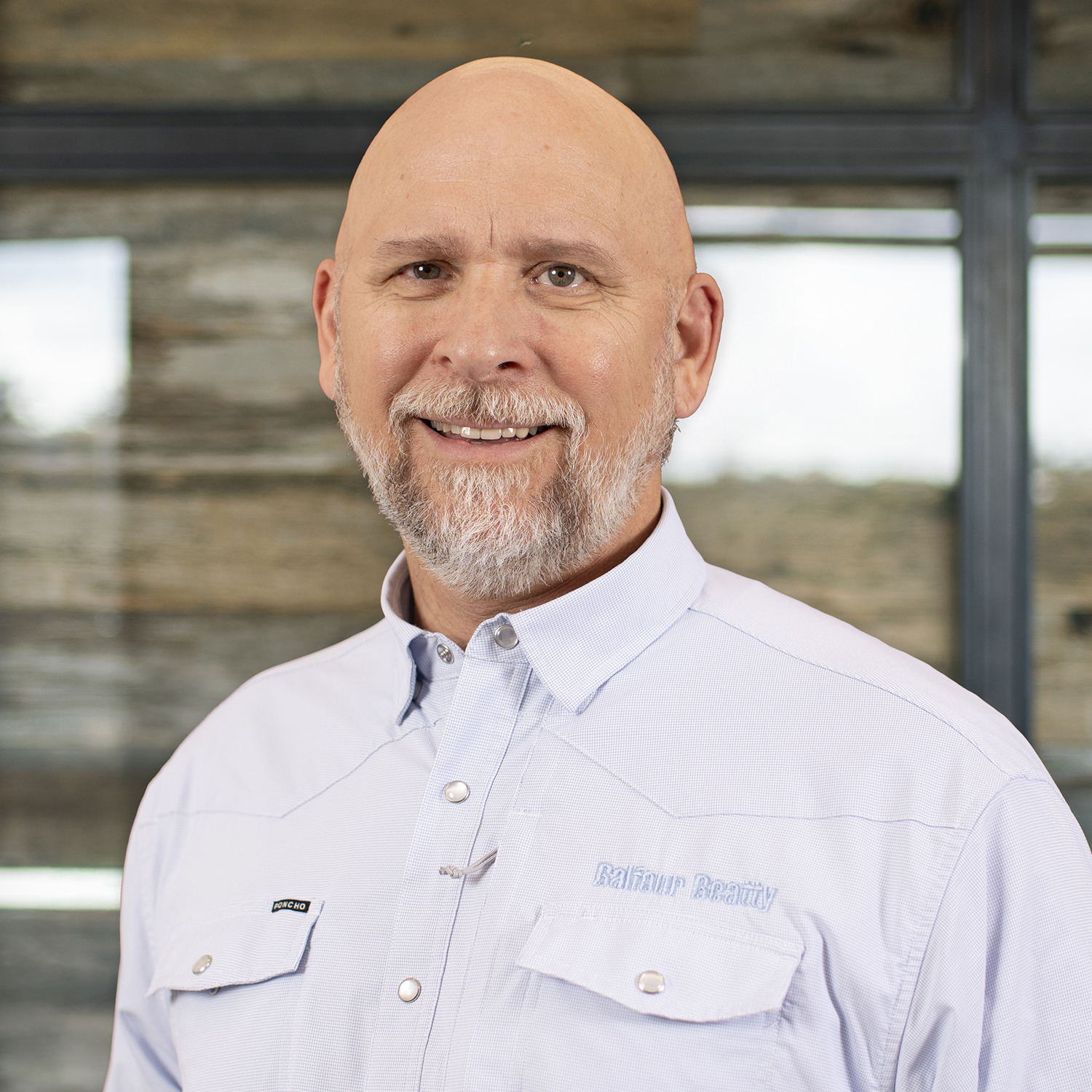Randy serves as Operations Director at Balfour Beatty and holds a degree in Mechanical Engineering from Penn State. He brings strong leadership and technical expertise to every project, ensuring operational excellence, team alignment, and client-focused delivery across all phases of construction.

Pete Distefano
Relentless Ally
Award-Winning Infrastructure Project Leadership
Balfour Beatty’s infrastructure projects across the U.S. are incredibly complex balancing acts of countless trade partners, staff teams, government agencies, safety and traffic concerns and more. Managing that degree of complexity requires a leader who remains cool under incredible pressure, prioritizes client communication and who is willing to test the boundaries of possibility in the pursuit of ever better project outcomes.
Operations Manager Pete Distefano, a 20-year Balfour Beatty veteran, may be quick to share his accolades among an equally incredible team, but his leadership on Southeast infrastructure projects produces results that speak for themselves in accelerated schedules and cost savings. Through relentless client advocacy, creative preconstruction and operations solutions and more, Pete accepts nothing less than excellence for the projects that keep our economies and communities moving like Effingham Parkway, Maysville Bypass and Surf City Bridge Replacement.
Conjuring Time Out of Thin Marl
On all these projects and, more recently, the Harkers Island Bridge Replacement in Harkers Island, North Carolina, Pete cultivates high-performing teams for whom collaboration is the central driver of innovation, all in the name of reducing risk for the North Carolina Department of Transportation (NCDOT).
Protracted delays on infrastructure projects are so common that they have virtually become a pop culture trope. But Pete’s leadership on Harkers Island – a monumental project replacing a 3,200-foot, fixed-span intracoastal bridge – led to substantial completion a year ahead of schedule. This warp-speed finish is a nearly unheard-of feat in highway and bridge construction.
The secret, according to Pete: leaning on the expertise of his team, top to bottom, and a willingness to identify innovative solutions, especially during preconstruction with ample lead time to make them happen. Using traditional methods to prepare for and place the bridge-supporting piles, for example, would have required significant excavation work.
“Operations Vice President Jay Boyd had the idea to save significant time by using a probe to punch through the hard subsurface layer of marl that necessitated excavation,” recalls Pete. “The idea was fairly simple but also ambitious and required NCDOT approval with assurance that the idea was feasible.”
Our team worked to negotiate a change order and project credit, but that financial incentive was contingent upon the idea succeeding. With now universal stakes – financial, schedule and Balfour Beatty’s reputation for operational excellence – Pete rallied the team to make this innovative idea a successful reality.
Achieving substantial completion a year ahead of schedule is a staggering accomplishment on its own, but the time saved can reap further dividends. From savings on labor to minimizing community impact and the intangible benefits of opening an arterial roadway far earlier than expected, our team delivered critical goals for NCDOT.
“As a team, we understand how critical these projects are to the communities where we live and work,” Pete says. “Our roadways and bridges move goods across the state, people to work and students to schools. Our work matters, and any effort to accelerate that work is never effort wasted.”
Through it all, Pete kept the entire project team united around the mission, maintaining a collaborative spirit as they worked through the challenges at hand and identified the best and most efficient path forward.
From Operations to Industry Leadership
As the Harkers Island project neared its ambitious early completion, the construction industry at large took notice – both of the project’s constructability merits and of Pete’s stellar leadership. In addition to the punch-driven piles, Pete and the team identified an opportunity to pursue other avenues of innovation, including testing state-of-the-art industrial exoskeleton systems for increased safety during formwork.
Pete was invited to the JEC Summit on Building and Infrastructure in Paris, France, to present on the project’s successes. In addition to the punch-driven support piles, the new Harkers Island Bridge is one of the first of its kind in the U.S. to eschew traditional steel-reinforced concrete in favor of glass and carbon fiber reinforced polymer fiber throughout its concrete structures. As steel-less, non-metal materials, GFRP and CFRP are far less prone to corrosion over time, an especially critical consideration for maximizing the lifespan of a coastal bridge structure.
Harkers Island also represented a significant accomplishment in terms of environmental protection and safety considerations. Federal and state regulations prohibit pile-driving activities in coastal waterways after a certain date each year to protect fish spawning grounds.
“Through months of team grit and overtime work, careful coordination with our environmental and safety teammates and state representatives, we kept the project moving while still protecting a vital coastal economy and ecosystem,” praises Pete.
Industry organizations also duly recognized the incredible successes of the entire Harkers Island project team, and this time with hardware. The Carolinas Associated General Contractors (CAGC) honored the team with a 2024 Pinnacle Award for exceptional delivery of the $60 million project, presented during CAGC’s 104th Annual Conference in Charleston, South Carolina.
“I’m incredibly proud of the feat our team has accomplished at Harkers Island, and especially because I know it was such a team effort,” Pete adds. “We understood the mission, understood the value of acceleration to our client and we pulled out every stop to make it happen safely, environmentally consciously and affordably.”
A True Construction Professional
Even as Pete’s project leadership and Balfour Beatty’s expertise garner accolades, awards and conference appearances, Pete maintains that he loves his job not for the recognition, but love of the construction process itself. Indeed, even for the excitement of using heavy civils machinery and state-of-the-art aerial videography drones.
“Our Buildings teammates build incredible projects, but on the infrastructure side, the machines are bigger,” Pete says with a wry smile. “That still excites me, but I enjoy even more that we get to build the infrastructure that will connect people, places and business for decades to come.”
Read More

Eric Clark
Relentless Ally
Charting a New Course
Strong leadership is vital to expansion. When looking to break into new markets, strong teams are foundational for success. In the Mid-Atlantic, Eric Clark and a dynamic group of operations experts lead the way through their shared values of collaboration, empathy and a relentless dedication to the communities they serve.
In and around Central Virginia, Eric supports active projects by assisting our project teams in overcoming challenges, securing the resources they need or connecting with potential clients to identify new opportunities. Eric is a Relentless Ally committed to supporting operations teams as they provide essential buildings for rapidly growing communities.
Expanding Horizons
Eric and his teammates are expanding Balfour Beatty’s operations into the Richmond and Hampton Roads communities of Virginia. Although the team has been operating in the area for many years, they recently set their sights on putting down roots and getting more established.
“We’ve been here for quite some time, and we’ve built a great core group of people,” says Eric. “We saw an opportunity to grow our market presence, and we’re thrilled to begin this next chapter.”
The Richmond and Hampton Roads team plans to expand their presence in the federal, institutional and higher education markets, building upon the Mid-Atlantic’s impressive 93-year history in the region. The team has hit the ground running and is actively engaged in several significant projects, partnering with clients like the College of William and Mary and their repeat-client, the US Army Corps of Engineers.
“This is an opportunity to serve the central Virginia community, using our established local expertise to support the region’s growth and development,” says Eric. “Our commitment to excellence and the relationships we’ve built in the community have laid a strong foundation; we’re excited to deliver exceptional results for our clients and communities.”
Returning the Favor
Eric is no stranger to working in the field. He began at Balfour Beatty after graduating from Virginia Tech in 1998, joining the company as a project engineer. As the years progressed, he has risen through the ranks and experienced many parts of the business in the process.
The journey of Eric’s career gives him insight into the unique challenges his teammates experience at every level of the business. Now, he’s dedicated to living out our people-first culture and supporting the next generation.
“I had so many opportunities from my leaders throughout the years to develop in my career,” says Eric. “Now, I’m always looking for ways to develop others and provide them opportunities to get to the next level in their careers.”
For Eric, the value of mentoring cannot be overstated. Not only does it grow a network of exceptional construction leaders, but it also establishes a culture in which personal connections, teamwork and collaboration are paramount to success.
“Creating collaborative environments allows our teams to excel,” says Eric. “That collaboration leads to successfully navigating project challenges and accelerated schedules, ultimately ensuring that we can deliver excellent projects that meet our clients’ unique needs.”
Coming Full Circle
During his days as an assistant project manager, Eric was assigned to the National Museum of the Marine Corps, primarily supervising field crews during the fit-out phase of the project. The 120,000-square-foot facility was nearing completion when Eric joined the team, working the night shift and finalizing the lighting in the main gallery.
Over ten years later, Eric found himself once again at the museum, this time as a project executive. For the phase 2 expansion project, the team more than doubled the space, adding new exhibit galleries, a large screen theater and a student education center.
“It was a really full-circle project for me,” explains Eric. “I was engaged in the initial project from a young age and felt like I was just finding my way in the industry. Being able to come back so many years later and lead the team that put the expansion on has been a highlight of my career.”
The museum has received extensive recognition, with the original project earning more than a dozen recognitions and the expansion project earning recognitions from Associated Builders and Contractors (ABC) of Metropolitan Washington and Virginia and NAIOP Northern Virginia. It is one of Balfour Beatty’s signature projects in the Mid-Atlantic, and a testament to our team’s emphasis on collaboration and commitment to bringing our clients’ visions to life.
Stepping Fearlessly in the Future
As the team charts a new course in Central Virginia, careful planning and preparation set the foundation for building to last. New challenges and unexpected obstacles are sure to come, but with a strong, collaborative culture as their guidepost, Eric and his teammates are ready to meet them head-on.
Read More

Allison Black
Relentless Ally
Passionate About Partnership
When you cut your professional teeth in the restaurant industry at the age of 16, you learn a thing or two about how to anticipate people’s needs for seamless service and personal connection.
That’s exactly where new Arizona Business Development Director Allison Black started, and her career in the more than 21 years since has encompassed a grand tour of the hospitality and architecture, engineering and construction (AEC) industries. At each step along the way, Allison has refined and refocused her commitment to fostering productive connections between teams, people and projects.
In her past professional experiences, Allison’s work has naturally brought her close to Balfour Beatty’s orbit on multiple occasions – at one point, she even attended an open house event at our Scottsdale, Arizona offices in 2018, where she met with and learned from local leadership. After her time with global design firm FITCH (a WPP Company) and later Henderson Engineers, a national building systems firm, Allison heeded the call to collect the final stamp in her AEC passport.
“I couldn’t be prouder to join a team that is so trusted and respected, both in Arizona and nationally,” Allison says. “As a lifelong communicator, strategic marketer and business development professional, I’m excited to help our teams and clients connect the dots and identify new opportunities for growth, partnership and successful projects.”
Balfour Beatty’s Arizona operations have established a well-earned reputation as the contractor of choice for large-scale hospitality projects, including the ongoing Grand Hyatt Scottsdale Resort at Gainey Ranch and past work like Mountain Shadows Resort and The Fairmont Scottsdale. While Balfour Beatty’s hospitality market leadership continues building on this momentum, Allison also sees Arizona as a strategic growth market for many other sectors and is committed to finding new avenues for opportunity.
“Like in other parts of the country, many Arizona developers are diversifying portfolios and adjusting to our status as a hub of commercial mixed-use developments, retail and entertainment destinations and other rapid growth markets like data centers,” Allison adds. “Balfour Beatty is well-positioned to take on these growth areas and more.”
Allison is originally from Northern California east of the Bay Area, but became an Arizona State University Sun Devil and received her bachelor’s degree in communications and business. Throughout her career, she has participated in multiple professional organizations and committees, including the International Council of Shopping Centers (ICSC), the Urban Land Institute’s Women’s Leadership Initiative (ULI-WLI) and the Arizona Association of Economic Development (AAED).
“Allison is a fantastic addition to our team in Arizona,” says Vice President Jay McQuarie. “She has an innate sense of client relationship-building and advocacy and a unique drive to see our clients connected to the teams and project solutions that best suit their needs.”
Read More

Landon McQuestion
Relentless Ally
Leading an Estimating Dream Team
Vice President of Preconstruction Landon McQuestion has approached his career as an estimator with a serial inability to sit still. As estimators constantly chase a moving matrix of prices and timetables, so too has Landon relentlessly pursued opportunities to push the boundaries of tech-enhanced preconstruction and build teams that share his and Balfour Beatty’s client-first values and lean leadership.
Today, Landon leads a team that, though based in California, is actively leaving an indelible mark on our preconstruction practices nationwide. Landon is also Balfour Beatty’s foremost expert on DESTINI Estimator and spearheaded its implementation over eight years ago.
While Landon and his team continue to test new and exciting AI-powered preconstruction tools, they still churn out more than 200 estimates per year, constantly driving down risk for our clients and trade partners.
From Trade Partnerships to Estimating Prowess
Landon attributes much of his estimating success to his roots in the trades, where he first worked as a metal stud framer and experienced the many ways that inaccurate estimating can result in cost escalations or delays that directly impact trade partners. After transitioning to the world of estimating, he brought this ground-level knowledge of the jobsite to bear.
It can be easy for estimators without that experience to overlook the granularity of a jobsite’s day-to-day activities and materials – how many tubes of caulk will be needed on a project? How many screws? How many cans of paint?
“At Balfour Beatty, we’ve created a culture where we expect that kind of precision as a higher degree of service to our clients,” Landon says. “Most of our estimators also come from the subcontracting world, so they understand the value of minute detail.”
While pursuing ever more accurate estimates is a clear benefit to our client, Landon’s and others’ trade backgrounds also ensure that our preconstruction teams have a clear window into our trade partners’ interests in achieving mutually beneficial goals.
“Large contractors can fall into a mindset that small preconstruction inaccuracies ‘come out in the wash,’ but we know better,” Landon adds. “Not only does that mentality betray our mission to deliver lean project solutions for our clients, but it lets down our trade partners for whom small changes can have outsized impacts.”
Embracing DESTINI
Collaboration – within, with clients and with design and trade partners – is at the core of Balfour Beatty’s behaviors as a company. When Landon first encountered the possibility of an even more collaborative and virtually accessible preconstruction environment via DESTINI Estimator, he seized the opportunity with the full support of company leadership.
At a base level, DESTINI provides a powerful tool for parametric estimating, able to extrapolate future estimates based on Balfour Beatty’s ever-expanding database of current and historical costs. In a time of persistent market volatility, owners increasingly rely on “napkin sketch” estimates during the earliest phases of project planning.
By implementing DESTINI Estimator, Balfour Beatty makes “napkin sketch” calculations as reliable as possible, and the following more concrete estimates are faster and more collaborative than ever.
“Many of our projects follow a collaborative alternative delivery contracting model like design-build or CM at-Risk, which already universally enhances collaboration between our team, the client and our design partner,” Landon says. “Using DESTINI combined with powerful 3D modeling tools, our preconstruction team and design partners can generate hypothetical sub-estimates in minutes, testing value engineering decisions and their cost implications in real time.”
What was once handled in a series of tedious back-and-forth emails (potentially losing the accuracy of cost data in the process) can now be accomplished instantly, accessible to all and accurate to the minute. Beyond just enhanced accuracy, the time savings significantly accelerates preconstruction and thus a client’s prospective speed to market.
Building on Success
Even after successfully implementing and improving upon DESTINI Estimator’s powerful advantages, Landon and his team have continued to explore new enhancements to the technology.
Under Landon’s leadership and out of commitment to Balfour Beatty’s mission, Senior Estimator Jorge Vargas has recently made DESTINI’s already collaborative environment even more user-friendly and accountable by creating a data-rich environment of trend management with software from Join. With the tool, clients, designers and our estimators can easily prioritize the most financially consequential value engineering options, comparing even minor design changes using DESTINI’s reliable cost predictions.
That data is largely managed by Estimator Hans Seggelke, and the entire process is overseen by Chief Estimator Neil Reilly, all while Director of Design Management Kristen Tuerk utilizes her architecture background to help clients identify the most lean and cost-effective design choices for any project.
While Landon is quick to divert attention away from himself and toward the dynamic preconstruction team he’s assembled, they’re all united by the same client-first values. Whether building schools, emergency operations centers or world-class aviation facilities, preconstruction professionals like Landon and the rest of our California team have the technical knowledge, collaborative mindset and willingness to try new and powerful tools necessary to create success.
Read More

Jennifer Rhoads
Relentless Ally
An Unwavering Anchor for Arizona
The remarkable story of Jennifer’s life and career isn’t one without its setbacks or sacrifices. But it’s equally filled with moments of great serendipity that, coupled with her ‘never-say-no’ work ethic, have molded Jennifer into a leader who is respected for her operational excellence, trusted for her authenticity and admired for her philanthropy.
As the daughter of a concrete superintendent who grew up toting reels of blueprints around jobsites, it was only natural to set her sights on the AEC Industry. She began her career at the noted architecture firm, Ruhnau Clarke & Associates. Jennifer’s destiny soon came calling when a superintendent from Douglas E. Barnhart Inc. recruited her to join their ranks, and she jumped at the chance.
In the decade thereafter, Jennifer received successive promotions in leadership and built an impressive resume. But in the wake of a significant personal event, Jennifer made the difficult decision to move back to her home state of Arizona where Barnhart did not maintain a presence. Although Jennifer soon found work with another contractor, she deeply missed the Barnhart team and culture and longed to return.
That all changed in an unexpected twist of fate at the most unexpected of places: the 2015 Arizona Bike Week. To her great surprise, Jennifer spotted Balfour Beatty’s signature blue signage at a WestWorld project. In the years following Jennifer’s departure, Balfour Beatty significantly expanded its West coast presence, acquiring not only Barnhart but also Howard S. Wright’s Northwest and Arizona operations.
Jennifer immediately called Brian Cahill - then president of Barnhart - with a simple request: “I want to come home.”
Builder, Doer, Leader
And back home Jennifer came. Since that time, she has been instrumental in growing our Arizona operations and embracing the team’s “builder-doer” model.
Whether she’s helping bring a large-scale hospitality project out of the ground, executing a fast-track special project for one of her many valued financial clients, pitching in on an estimate or leading business acquisition initiatives, no task is too big or small for Jennifer to raise her hand. She’s even stepped up in a mentoring capacity to lead the Arizona chapter of Balfour Beatty’s Connecting Women employee affinity group and serves as an Ambassador for our My Contribution enterprise-wide program for employee-led business change.
“I’m a roll up your sleeves, get it done, jack of all trades,” affirms Jennifer. “It’s in my blood to be juggling five million things at once.”
That grit and determination served Jennifer well in 2020 when she faced a serious health challenge. As those who know her tenacity could have predicted, Jennifer didn’t just bounce back from this trial – she leveraged it to find a new and meaningful purpose.
When Jennifer returned, she requested the opportunity to take on leadership of the Arizona team’s special projects operations. She instinctively recognized the market’s incredible growth potential and was attracted to the quick-turn nature of the work. Vice President Jay McQuarie didn’t hesitate to entrust her with the role.
A Servant Leader for Special Projects
Through her servant-leader approach, Jennifer has successfully nurtured and grown relationships with existing special projects clients such as Vanguard while bringing new clients into the fold and expanding Balfour Beatty’s market share. Today, she manages an impressive portfolio encompassing several national clients.
Although servant leadership can entail many different characteristics, to Jennifer, the term can be boiled down to a central trait: commitment. Whether it’s a work order to patch paint or the renovation of an entire trading floor, Jennifer is wholly committed to the success of her clients, projects and partners. She has even created a highly customized SOP for each client that communicates their unique needs and delivers on their goals with every project.
As an enduring sentiment of her commitment, Jennifer concludes every OAC meeting with a personal tagline: “Morning, noon or night, call me. I’m here for you.”
Building Bridges, Molding Minds
Jennifer certainly answers the call for her clients. In an even broader sense, she has answered the call for her community - both locally and globally. She not only leads Balfour Beatty’s longstanding partnership with non-profit Arizona Angels for Children but also served as a member of Balfour Beatty’s 2018 Bridges to Prosperity team which built a 430-foot footbridge that provides safe, year-round access for the Espiritu Santo community near Cochabamba, Bolivia.
“When I learned about the opportunity to use our expert engineering and construction skills to serve communities in need, I knew it was a calling I was uniquely suited to answer,” Jennifer says. “Providing opportunities for others has always been a very important value for me.”
In the years following, Jennifer has continued to support Balfour Beatty’s Bridge to Prosperity mission in a fundraising leadership capacity.
Jennifer is known amongst her Arizona teammates as “Momma Jen.” Her deep care is profoundly manifested in ways both great and small and in ways that can easily be described, and yet are somehow profoundly intangible to those in her sphere. With steadiness, strength and a servant’s spirit, Relentless Ally Jennifer Rhoads is an anchor for Arizona.
Read More

Jonathan Pearch
Relentless Ally
Building Relationships to Last
During his 16-year career with Balfour Beatty, Vice President Jonathan Pearch has helped build some of Florida’s largest and most complex projects. From the iconic, 263,000-square-foot Dr. Phillips Center for the Performing Arts to the 30,000-seat Florida Atlantic University (FAU) Stadium, the Hyatt Regency Orlando and more, Jonathan has developed a unique insight into the levels of collaboration projects of that mega projects require across diverse market sectors.
Perhaps that’s why Jonathan, who began his remarkable career with Balfour Beatty as a four-time intern, describes his journey in terms of the people he’s encountered along the way. From trade and design partners to his valued clients, Balfour Beatty teammates and members of the local AEC community, Jonathan knows first-hand that effective leadership is all about relationships. And Jonathan builds them to last.
When local leadership recognized an opportunity to expand and diversify our South Florida operations, they looked no further than Jonathan to grow the company’s pipeline in higher education and municipal markets among others. Although the elevation in leadership required Jonathan to re-locate his young family, he jumped at the chance, bringing with him the strong cultural and relational foundations he cultivated in Central Florida.
“I was fortunate to work on large project teams early in my career and observe the behaviors that helped everyone navigate the inevitable challenges that arise,” recalls Jonathan. “I strive to establish project cultures rooted in trust, transparency and accountability, because those become solutions-oriented teams.”
On the $36 million expansion and renovation of The Alfond Inn at Rollins, for example, the project team encountered an issue that could have completely derailed the schedule and budget, or at worst, even required a complete re-design.
While preparing to pour foundations on the hotel’s five-story, 81,000-square-foot addition, the team discovered grid alignment issues in the existing structure. With concrete teams mobilized, the clock was ticking to identify a solution.
While some contractors might have put the onus back on the client, this team proactively rolled up their sleeves and got to work under Jonathan’s leadership. As the team collaborated on a solution, Jonathan prioritized maintaining open and honest lines of communication with all partners regarding real-time or anticipated impacts.
Together, the team determined it was feasible to rotate the grid and partnered with the City of Winter Park on resulting setback and easement concerns. But the team didn’t simply solve the problem—they developed an innovative sequencing plan to recoup the time lost and ultimately finished the project on schedule.
“As the leader of the project, it is your job to establish absolute trust with the owner beginning day one,” asserts Jonathan. “That starts by understanding their values and goals and making them your own.” It’s a lesson he learned from his closest mentor at Balfour Beatty, Senior Vice President Brian Prebenda.
If Jonathan doesn’t immediately know the answer to one of his client’s challenges, or simply needs a thought partner to offer up a different perspective, he’s quick to tap the immense network he’s cultivated over the years, including peers at the Associated Builders and Contractors (ABC) Central Florida Chapter, where he has served on the Board of Directors. With a deep understanding that our success hinges upon the success of our trade partners, Jonathan extends that same collaborative spirit into the local craft community.
For Jonathan, no matter the size, scope or geography in which we’re executing work, our recipe for success is simple: putting people first + building trusted relationships with a shared focus on operational excellence = exceptional project outcomes.
It’s a recipe that has already yielded great success in South Florida, with recent wins from first-time client, Nova Southeastern University, on their $23.9 million Terry Dining Renovation and an $90 million Student Housing project with long-time client, Florida Atlantic University (FAU).
From his humble roots as an intern to leading an entire market, Jonathan Pearch embodies the DNA of a Relentless Ally and is a passionate steward of Balfour Beatty’s unwavering promise: we build to last.
Read More













